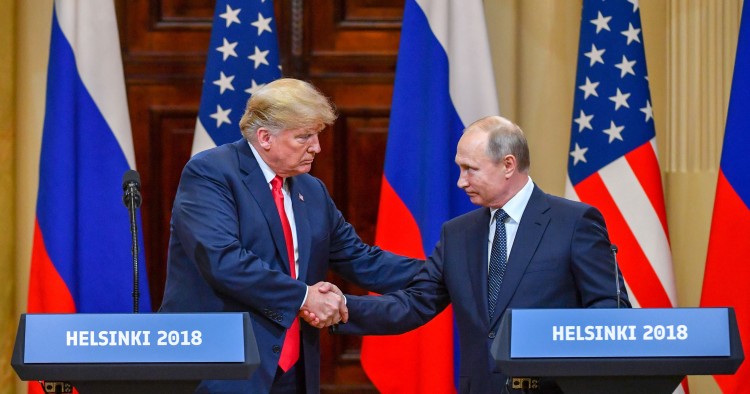Despite the absence of a public and formal account of what transpired during the meeting between Presidents Trump and Putin in Helsinki on Jul. 16, it seems that there is at least tacit agreement that effectively endorses the Syrian regime’s takeover of southern Syria and limits Iranian presence in Syrian areas near the Jordanian and Israeli borders.
Such an outcome would have significant implications on Jordan’s security and stability. From Amman’s perspective, the Helsinki agreement only confirms what was already known to Jordanian decision-makers; that the U.S. wants to disengage from the Syrian conflict and leave Russia with sole responsibility for stabilizing the country after years of painful and devastating fighting. Likewise, Amman also seems to recognize that the Syrian regime no longer sees any need for a negotiated solution to end the conflict; it was hard-pressed to consider doing so when it controlled only 10-15 percent of the country’s territory, but now that it has consolidated its gains, the regime has even less incentive to seek compromise.
Weeks ahead of the summit, the Jordanian government announced that it could not accept any more Syrian refugees but would continue to provide humanitarian assistance to Syrians inside Syria. This was a departure from Jordan’s long-standing core value of providing safe haven to those fleeing persecution and conflict in the region.
The Jordanian decision was partly driven by concerns that regime incursions in southern Syria would lead to a mass exodus of refugees fleeing to Jordan. While the country has successfully absorbed around 1.3 million Syrian refugees since the onset of the conflict in 2011, this came at a time when international assistance to the country was significantly greater, international attention was higher, and refugees arrived in more manageable waves.
Another likely Jordanian concern was that fighters and/or sleeper cells would be among those seeking refuge. Weeks following the June decision to halt refugee intake, ISIS conducted suicide bombings in the southern Syrian city of Suweida that led to the deaths of at least 166 people. This gruesome attack is emblematic of Amman’s fears that taking on additional refugees would risk letting in ISIS members embedded within would-be refugee populations. Separately, the decision also seems to be the culmination of an internal Jordanian debate regarding the country’s stretched carrying capacity amid the devastating economic crisis that it has been experiencing.
Looking forward, Jordanian priorities are threefold: the country is undoubtedly concerned about whether Russia is willing or able to enforce the agreement to limit the Iranian presence in southern Syria. It appears that both Israel and Jordan have separately lobbied the U.S. and Russia to limit this presence within 100-kilometer of their respective borders. Here, Jordan can be somewhat assured that Israel can use its own leverage with the U.S. and Russia to ensure this agreement is upheld. It could also see Israeli military action against Iranian targets inside Syria should this agreement be violated.
Another concern for Jordan is whether Russia will be able to prevent a further outbreak of violence and retribution once the regime has regained control over opposition-held areas. In this sense, Amman does not want southern Syria’s population to face an uncertain future. While Russia has enabled much of the violence in Syria over the past years, it may now have a vested interest in ensuring that it can play a positive role in closing the chapter on this bloody period of history, if at all possible. Two weeks ago, Russian military police reportedly entered rebel-held towns as part of a guarantee to surrendering rebel groups that the regime and its allies would not take revenge on them or civilians living in their areas of control.
Lastly, Jordan would be interested in restoring its trade with Syria once the regime retakes control of the Jaber-Naseeb border crossing, which has been closed since 2015. Overland trade between the two countries was reportedly valued at more than $615 million in 2010, and is even greater if one includes Jordanian goods that depended on Syria as a transit route to other markets. Restoring trade would be a boon for a cash-strapped economy that has lost its two main trading partners, Iraq and Syria, due to conflict in both countries. Yesterday, a flurry of activity in the Jordanian media suggested that preparations were underway for the Jaber-Naseeb crossing to be reopened imminently but this was not officially confirmed.
Russia is becoming the indispensable balancer in the Middle East, as was recognized at the Helsinki Summit. Jordanians living in cities along the border with Syria are separated by just over a mile from Syrian cities where shelling has intensified over the past weeks. Jordan will continue to seek to work with Russia and the U.S., as it did when it helped broker the original cease-fire agreement between them and others in Amman in July 2017, to continue to safeguard its interests. It will also place a lot of faith in Russia, in hopes that the country will be able to use its influence to restore stability in what has been a tragic conflict.
Photo: Yuri Kadobnov/AFP/Getty Images
The Middle East Institute (MEI) is an independent, non-partisan, non-for-profit, educational organization. It does not engage in advocacy and its scholars’ opinions are their own. MEI welcomes financial donations, but retains sole editorial control over its work and its publications reflect only the authors’ views. For a listing of MEI donors, please click here.













